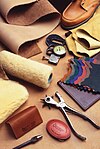Morocco leather


Morocco leather (also known as Levant, the French Maroquin, or German Saffian from Safi, a Moroccan town famous for leather) is a soft, pliable form of leather widely used for gloves and the uppers of ladies' shoes and men's low cut shoes, but traditionally associated with bookbindings, wallets, linings for fine luggage, and the like.
Originally Morocco leather was imported to Europe from Morocco, and from the late 16th century it was valued in luxury bookbindings in Western countries because of its strength and because it showed off the gilding. It was also used in the Islamic world from an earlier date.
However Morocco was often not the original source of the leather. Some of the highest quality Morocco leather, usually goat skin, used in book binding was sourced from Northern Nigeria.[1] The leather tends to be more famous than the breed of goat that originally produced it. The leather is sourced from the Sokoto Red breed, which is indigenous to Guinea and Sudan Savannah of Nigeria and Maradi Region in Republic of Niger.[2][3]
The finest grades of Morocco leather are goatskin, but by the late 19th century other skins often were substituted in practice, particularly sheepskin and split calfskin. For example, French Morocco is a variety made of sheepskin.[4] The tanning process varied widely, but the traditional tanning material was sumac. The traditional tanning process was skilled and elaborate; according to the application, the preparation either would aim for a carefully smoothed finish, or would bring up the grain in various patterns such as straight-grained, pebble-grained, or in particular, in a bird's-eye pattern. Morocco leather is practically always dyed, traditionally most often red or black, but green, brown or other colors also were available, and in modern times there is no special constraint on color.[5][6]
Miscellany[]
The song "(We're Off on the) Road to Morocco" sung by Bing Crosby and Bob Hope includes the line "like Webster's dictionary we're Morocco bound".
References[]
- ^ Cambridge University Press
- ^ "The Red Maradi Goat (Capra hircus)".
- ^ Habibu, Buhari; Kawu, Mohammed; Makun, Hussaina; Aluwong, Tagang; Yaqub, Lukman; Dzenda, Tavershima; Buhari, Hajarah (2017-03-31). "Influences of breed, sex and age on seasonal changes in haematological variables of tropical goat kids". Archives Animal Breeding. 60 (1): 33–42. doi:10.5194/aab-60-33-2017. ISSN 2363-9822.
- ^ Ure, Andrew. A Dictionary of Arts, Manufactures, and Mines. 1853. Little, Brown.
- ^ Davis, Charles T. The Manufacture of Leather. 1885. Henry Carey Baird.
- ^ Watt, Alexander. Leather Manufacture. 1906. van Nostrand.
Further reading[]
- Freudenberger, Walter (1959). The Hide and Skin Markets of the World. Printed for private circulation. Ilford, Essex: CW Clark & Co.
| Wikimedia Commons has media related to Morocco leather. |
- Leather
- Bookbinding
